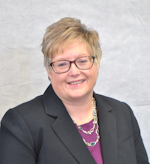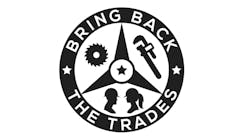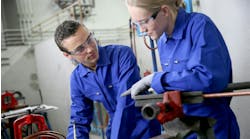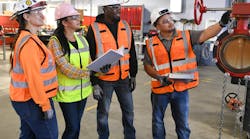Latest from Training
Sponsored
While there are differing opinions on the efficacy of unions in this country, many large cities such as Chicago, Los Angeles and New York City require union workforces on large commercial, industrial and municipal construction projects.
The latest Bureau of Labor Statistics data (as of 2020) states the total number of U.S. plumbers, pipefitters and steamfitters is 469,900; 380,400 HVACR mechanics and installers; and 418,200 welders, cutters, solderers and brazers in the same year.
The 133-year-old United Association of Journeymen and Apprentices of the Plumbing and Pipefitting Industry of the United States and Canada (UA) represents nearly 355,000 plumbers, pipefitters, sprinkler fitters, HVACR service technicians, welders and pipeliners in North America.
For many years, the UA and its locals have had the distinction of offering top-notch training to its members. In the first half of the 20th century, the UA formalized apprenticeship training programs: making a five-year apprenticeship mandatory in 1921; and, in 1938, holding that all apprentices be members of the UA and attend related training classes.
Its National Plumbing Apprenticeship Plan of 1936 was the first set of standards governing apprenticeship to win federal government approval.
“The UA provided me with everything I needed for my plumbing career: my education, technical training and workforce training,” recalls Laura Ceja, UA’s special representative for training and outreach.
She joined the UA 25 years ago as an apprentice plumber/pipefitter out of the UA’s Local 761, Burbank, Calif. Ceja worked her way through the apprenticeship program and, taking the credits she earned, applied them toward an associate's degree. She also earned a bachelor's degree in education and a master's degree in leadership and management.
“Anyone taking our program earns 45 college credits, and we also have additional in-service training, where apprentices can take classes that apply to their associate’s degree at no cost,” Ceja explains. “So, it was at no cost to me when I joined the program. At the age of 19, I was able to get my health benefits and start building toward my pension. Everything was taken care of.”
She worked as an apprentice, a journeyman and a foreman, and was a project engineer and estimator for a design-build contractor. Ceja also worked as a city inspector in Los Angeles and a senior plumbing inspector and training officer for nearly a decade.
“The UA reached out to me because of some of the outreach and recruitment I had done locally with some of our nonprofits here that help disadvantaged women get into the building trade,” Ceja notes. She joined the UA’s Education and Training Department in 2017 as a training specialist-national recruitment and outreach coordinator.
She was promoted to her current position in 2021.
Plumbing Ambassadors
“I believe there is a learned helplessness within our industry, where we sometimes have trouble finding young people to join the industry,” she explains. “However, at the UA, we know it's different. We train our people to conduct industry outreach and recruitment. And we bring that awareness, and we're looking for people who reflect our communities, such as women and underrepresented workers.”
To accomplish this, the UA uses ambassadors in its programs, especially women and underrepresented workers with leadership positions in the union.
“When we bring people into our programs and see women and people of color in those leadership positions, they feel welcomed,” Ceja notes. “They feel they belong here, that there are opportunities for them to advance.”
These outreach events include SkillsUSA, the American School Counselor Association, Future Farmers of America and the Association of Career and Technical Education.
“I always bring apprentice ambassadors: apprentices who are currently in the program but who are usually women, people of color, single parents, LGBTQ+, etc.,” she adds. “And they're demonstrating that it doesn't matter who I am, where I come from, what I look like. If I can do the job and love what I do, I have an opportunity here. And they can demonstrate that when they talk to school counselors, too.
“Unless they have a close family member or relative, or a model in their life who can tell them the piping trades and the skilled building trades are the way to go, they default to college. However, college is education; it's not career training.”
For example, local UA training centers are helping both boys and girls with Scout plumbing badges (see sidebar).
During the height of the COVID-19 pandemic, some of the UA training centers reached out to homeschooling organizations and religious institutions to get the apprenticeship message to them.
“That hits all the [homeschooling] gatekeepers: the teacher, the parents and the school counselor,” she says. “We also partner with our local pre-apprenticeship, tradeswomen, one-stop work centers, alternative learning centers, GED prep centers, foster home youth, correctional facilities, disabled veterans and the Department of Labor's Women's Bureau.”
A $300 Million Yearly Endeavor
The UA has about 274 union locals and close to 300 physical training locations across the United States in Canada, Ceja says—and the training is comprehensive.
“We have everything from hands-on, advanced plan reading and related drawing, advanced valve repair, basic electricity, building control, foreman training, and more,” she explains. “We have a program track for students who want to learn about business ownership; we partner with the Mechanical Contractors Association of America. And the UA provides different regional training classes for journeymen to take and learn different skills.”
“The UA spends nearly $300 million a year on training across the country,” Ceja explains. “That's because our membership contributes to the training fund to provide free education and training to our students.”
She adds that technology is changing rapidly, and UA’s training centers keep up with current trends: “If a member wants to come in and try a new welding practice, they can sign up at no cost. I believe it's how we attract young people, too—that availability to take the technical training using the latest design software, a lot of virtual design construction.”
The organization also administers the Veterans in Piping program, which helps veterans transition out of the military into lucrative civilian construction careers. With local unions across the country, they can relocate wherever they want.
The UA is committed to ensuring its members are trained on the latest technologies and newest plumbing products—regardless of where they are in their career paths.
“We're not like a two-to-four-year university: we are for the life of the workers, so we are for the life of the members,” Ceja concludes.
Kelly Faloon is a contributing writer to Contractor magazine and principal of Faloon Editorial Services. The former editor of Plumbing & Mechanical magazine, she has more than 20 years of experience in the plumbing and heating industry and more than 30 years in B2B publishing. Faloon is a journalism graduate of Michigan State University.
Boy Scouts of America Plumbing Badge
1. Do the following:
a. Describe how a properly working plumbing system protects your family’s health and safety.
b. List five important local health regulations related to plumbing and tell how they protect health and safety.
c. Describe the safety precautions you must take when making home plumbing repairs.
2. Do the following:
a. Make a drawing and explain how a home hot- and cold-water supply system works. Tell how you would make it safe from freezing.
b. Make a drawing and explain the drainage system of the plumbing in a house. Show and explain the use of drains and vents.
3. Show how to use five important plumber tools.
4. Identify and describe the use of each of the following: washer, retaining nut, plunger (rubber force cup), solder, flux, elbow, tee, nipple, coupling, plug, union, trap, drainpipe and water meter.
5. Name the kinds of pipe used most often in a plumbing system. Explain why they are used.
6. Cut, thread and connect two pieces of metal pipe.
7. Under the supervision of a knowledgeable adult, solder three copper tube connections using a gas torch. Include one tee, two straight pieces and one coupling.
8. Do the following:
a. Replace a washer in a faucet.
b. Clean out a sink or lavatory

Kelly L. Faloon | Freelance Writer/Editor
Kelly L. Faloon is a contributing editor and writer to Contractor, Contracting Business magazine and HPAC Engineering and principal of Faloon Editorial Services. The former editor of Plumbing & Mechanical magazine, Faloon has more than 26 years of experience in the plumbing and heating industry and more than 35 years in B2B publishing. She started a freelance writing and editing business in 2017, where she has a varied clientele.
Faloon spent 3 1/2 years at Supply House Times before joining the Plumbing & Mechanical staff in 2001. Previously, she spent nearly 10 years at CCH/Wolters Kluwer, a publishing firm specializing in business and tax law, where she wore many hats — proofreader, writer/editor for a daily tax publication, and Internal Revenue Code editor.
A native of Michigan’s northern Lower Peninsula, Faloon is a journalism graduate of Michigan State University. You can reach her at [email protected].







